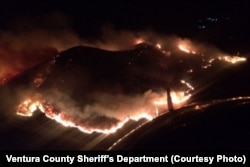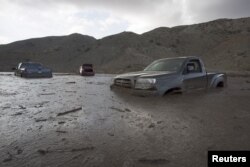Fire crews stopped the spread of a wind-whipped wildfire along the Southern California coast on Saturday, reopened a scenic highway and lifted an evacuation order for dozens of homes.
The 1,238-acre blaze in the steep foothills northwest of Ventura was 60 percent contained by nightfall and no homes burned, fire officials said at a news conference.
"We made tremendous progress today,'' said Tom Clemo, deputy fire chief from the neighboring city of Santa Monica, which aided the firefighting effort. "Despite the challenges of high winds, steep terrain, significant brush, we were able to bring a stop to all forward progress of the fire.''
About 600 firefighters from various agencies, aided by water-dropping helicopters, fought the blaze during the day. About 400 were expected remain on the line overnight.
The fire began late Friday night, and winds gusting to 50 mph pushed the flames down hills and over roads and railroad tracks, showering sparks on homes in coastal communities, fire officials said.
About 50 homes in the Solimar Beach community were placed under mandatory evacuation orders, and about 30 nearby homes were placed under voluntary evacuation.
However, the winds had died down by early afternoon. The evacuation order was lifted by nightfall and a stretch of the scenic Pacific Coast Highway was reopened.
At its peak, the fire closed a 15-mile stretch of an adjacent, six-lane freeway, U.S. 101. The freeway is a major route connecting Northern and Southern California, and its closure forced holiday motorists to narrow backcountry roads. But it was reopened Saturday afternoon.
The fire had also stopped rail traffic through the region, The Los Angeles Times reported Saturday.
A downed power line on private property is believed to have sparked the fire, said Tom Kruschke, a spokesman for the Ventura County Fire Department, who didn't know who owned the line. Wind may have felled the power line, he said.
Potential for mudslides
California has been suffering under drought conditions for the past four years. A strong El Nino, a warming weather phenomenon that is expected to peak in the first few months of the new year, is expected to bring heavy rains to the state.
Last week, state officials warned that heavy rains falling on areas where vegetation has been shriveled by drought or burned back by fires could lead to potential mudflows or landslides.
In October, a landslide trapped nearly 200 vehicles and closed a 13-kilometer (8-mile) stretch of State Route 58 in Kern County, about 175 kilometers (110 miles) north of downtown Los Angeles. At the time, local media reported at least a mile of the highway was clogged with mud up to nearly 2 meters (6 feet) deep.
"The drought, it's just made this whole situation worse. … That area that slid [in October]? It's not green. There's not even grass on it. It's so dead because of lack of rain," Deborah Wong, a deputy director for the California Department of Transportation, told the Times last week. "If there's no root structure to hold the mountain back, or at least the topsoil, it's coming down."
Some information for this report came from AP.













